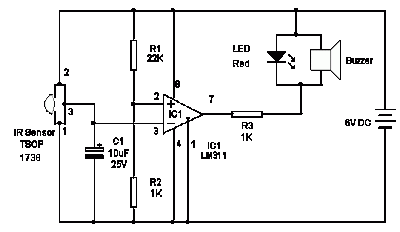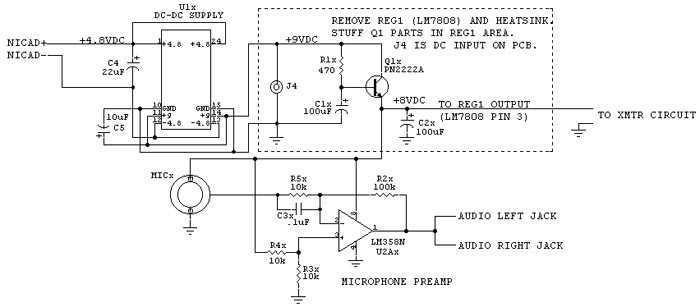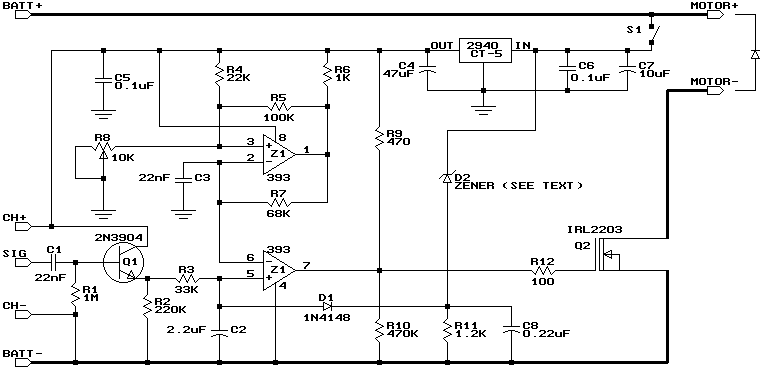
Build an IR Beam Breaker

The IR Beam Breaker Circuit Diagram is designed as an infrared beam breaking alarm suitable for use in entryways or passageways. This circuit utilizes the well-known IR sensor module TSOP 1738, which detects 38 kHz infrared pulses emitted by the transmitter's IR LED. The effective range of this circuit is approximately 5 meters, provided that the transmitter and receiver are properly aligned. The TSOP 1738 sensor module is specifically responsive to pulsed infrared rays at 38 kHz and will not detect continuous infrared light from the IR LED. Consequently, a transmitter circuit, such as one based on a 555 timer IC, is necessary to generate the required pulsed output. Any standard 555 timer-based transmitter circuit can be employed, as long as it produces an exact 38 kHz signal. The TSOP 1738 outputs 5 volts and 5 mA of current when no infrared rays are detected. Its output is a current sink, meaning that upon receiving 38 kHz infrared rays, the output drops to zero. The supply voltage for pin 2 of the module should be maintained between 4.5 to 6 volts, as exceeding 6 volts may damage the device. While the module is generally resistant to ambient light interference, it may respond to noise sources such as electronic ballasts. The output from the IR module is connected to the inverting input of IC1, which is an LM311 precision voltage comparator. Although it resembles common operational amplifiers like the LM741, CA3130, CA3140, and TL071, the pin configuration and output characteristics of the LM311 differ from those of standard op-amps.
The IR Beam Breaker Circuit operates on the principle of modulation and demodulation of infrared signals. The transmitter circuit, built around the 555 timer IC, is configured in astable mode to generate a continuous square wave output at 38 kHz. This signal is fed to an infrared LED, which emits pulses of infrared light. The TSOP 1738 IR sensor module, positioned within the line of sight of the IR LED, detects these pulsed signals. When the infrared beam is interrupted, the TSOP 1738 stops receiving the 38 kHz pulses, resulting in a change in its output state.
The output from the TSOP 1738 is connected to the inverting input of the LM311 comparator. The non-inverting input of the LM311 is typically connected to a reference voltage, which can be set using a voltage divider or a potentiometer. When the TSOP 1738 detects the presence of the 38 kHz signal, its output is high (5V), keeping the output of the LM311 low. Conversely, when the infrared beam is broken, the output from the TSOP 1738 drops to zero, causing the LM311 to switch its output state to high.
This high output from the LM311 can be used to trigger an alarm, activate a relay, or perform any other desired action, such as illuminating an LED or sending a signal to a microcontroller. The circuit's design ensures that it is sensitive to interruptions in the infrared beam while being robust against false triggering from ambient light, making it suitable for security applications. Proper alignment and calibration of the transmitter and receiver are crucial for optimal performance, and consideration should be given to environmental factors that may affect infrared transmission, such as obstacles or reflective surfaces.IR Beam Breaker Circuit Diagram. This is an Infrared beam breaking alarm ideal to use in entry or passages. It is based on the working of the popular IR sensor Module TSOP 1738 which senses 38 kHz Infrared pulses from the IR LED of the transmitter. Range of the circuit is about 5 meters if the transmitter and receiver are properly aligned TSOP 1738
IR sensor module responds to only 38kHz pulsed infrared rays. It will not sense continuous IR ray from the IR LED. So a transmitter circuit(as one in TV remote handset) based on 555 IC is required. Any standard transmitter circuit based on 555 IC can be used. But its output should be 38kHz exactly. TSOP 1738 gives 5 volt output and 5mA current in the off position. That is when IR rays are not available. Its output is current sinking so that when it receives 38kHz IR rays, output becomes zero. Pin 2 of the module should get a supply voltage between 4. 5 to 6 volts. Higher voltage above 6 volts will destroy the device. The module is generally immune to ambient light, but may responds to sources of noice such as electronic ballasts. Out put from the IR module is given to the inverting input of IC1. LM311 is a precision voltage comparator. It looks like the common Op Amps like LM741, CA3130, CA 3140, TL071 etc. But its pin connections and output are different from other Op Amps. 🔗 External reference
The IR Beam Breaker Circuit operates on the principle of modulation and demodulation of infrared signals. The transmitter circuit, built around the 555 timer IC, is configured in astable mode to generate a continuous square wave output at 38 kHz. This signal is fed to an infrared LED, which emits pulses of infrared light. The TSOP 1738 IR sensor module, positioned within the line of sight of the IR LED, detects these pulsed signals. When the infrared beam is interrupted, the TSOP 1738 stops receiving the 38 kHz pulses, resulting in a change in its output state.
The output from the TSOP 1738 is connected to the inverting input of the LM311 comparator. The non-inverting input of the LM311 is typically connected to a reference voltage, which can be set using a voltage divider or a potentiometer. When the TSOP 1738 detects the presence of the 38 kHz signal, its output is high (5V), keeping the output of the LM311 low. Conversely, when the infrared beam is broken, the output from the TSOP 1738 drops to zero, causing the LM311 to switch its output state to high.
This high output from the LM311 can be used to trigger an alarm, activate a relay, or perform any other desired action, such as illuminating an LED or sending a signal to a microcontroller. The circuit's design ensures that it is sensitive to interruptions in the infrared beam while being robust against false triggering from ambient light, making it suitable for security applications. Proper alignment and calibration of the transmitter and receiver are crucial for optimal performance, and consideration should be given to environmental factors that may affect infrared transmission, such as obstacles or reflective surfaces.IR Beam Breaker Circuit Diagram. This is an Infrared beam breaking alarm ideal to use in entry or passages. It is based on the working of the popular IR sensor Module TSOP 1738 which senses 38 kHz Infrared pulses from the IR LED of the transmitter. Range of the circuit is about 5 meters if the transmitter and receiver are properly aligned TSOP 1738
IR sensor module responds to only 38kHz pulsed infrared rays. It will not sense continuous IR ray from the IR LED. So a transmitter circuit(as one in TV remote handset) based on 555 IC is required. Any standard transmitter circuit based on 555 IC can be used. But its output should be 38kHz exactly. TSOP 1738 gives 5 volt output and 5mA current in the off position. That is when IR rays are not available. Its output is current sinking so that when it receives 38kHz IR rays, output becomes zero. Pin 2 of the module should get a supply voltage between 4. 5 to 6 volts. Higher voltage above 6 volts will destroy the device. The module is generally immune to ambient light, but may responds to sources of noice such as electronic ballasts. Out put from the IR module is given to the inverting input of IC1. LM311 is a precision voltage comparator. It looks like the common Op Amps like LM741, CA3130, CA 3140, TL071 etc. But its pin connections and output are different from other Op Amps. 🔗 External reference





